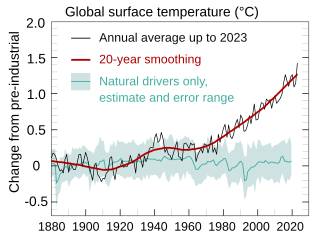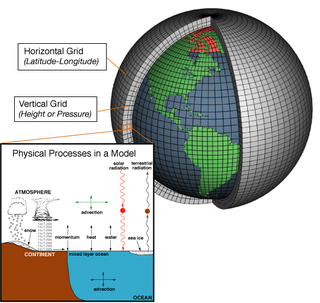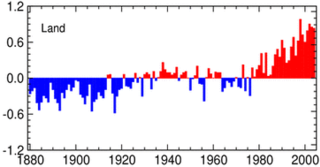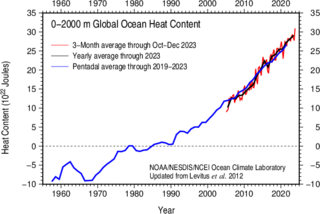 W
WClimate change includes both the global warming driven by human emissions of greenhouse gases, and the resulting large-scale shifts in weather patterns. Though there have been previous periods of climatic change, since the mid-20th century the rate of human impact on Earth's climate system and its global scale have been unprecedented.
 W
WAn abrupt climate change occurs when the climate system is forced to transition to a new climate state at a rate that is determined by the climate system energy-balance, and which is more rapid than the rate of change of the external forcing. Past events include the end of the Carboniferous Rainforest Collapse, Younger Dryas, Dansgaard-Oeschger events, Heinrich events and possibly also the Paleocene–Eocene Thermal Maximum. The term is also used within the context of global warming to describe sudden climate change that is detectable over the time-scale of a human lifetime, possibly as the result of feedback loops within the climate system.
 W
WAntarctic sea ice is the sea ice of the Southern Ocean. It extends from the far north in the winter and retreats to almost the coastline every summer, getting closer and closer to the coastline every year due to sea ice melting. Sea ice is frozen seawater that is usually less than a few meters thick. This is the opposite of ice shelves, which are formed by glaciers, they float in the sea, and are up to a kilometer thick. There are two subdivisions of sea ice: fast ice, which are attached to land; and ice floes, which are not.
 W
WThe Arctic ice pack is the sea ice cover of the Arctic Ocean and its vicinity. The Arctic ice pack undergoes a regular seasonal cycle in which ice melts in spring and summer, reaches a minimum around mid-September, then increases during fall and winter. Summer ice cover in the Arctic is about 50% of winter cover. Some of the ice survives from one year to the next. Currently, 28% of Arctic basin sea ice is multi-year ice, thicker than seasonal ice: up to 3–4 m (9.8–13.1 ft) thick over large areas, with ridges up to 20 m (65.6 ft) thick. The regular seasonal cycle there has been an underlying trend of declining sea ice in the Arctic in recent decades as well.
 W
WThe Arctic sea ice decline has occurred in recent decades by sea ice in the Arctic Ocean melting faster than it refreezes in the winter. The IPCC, in its Fourth Assessment Report, stated that greenhouse gas forcing is predominantly responsible for the decline in Arctic sea ice extent. A 2007 study found the decline to be "faster than forecasted" by model simulations. A 2011 study suggested that it could be reconciled by internal variability enhancing the greenhouse gas-forced sea ice decline over the last few decades. A 2012 study, with a newer set of simulations, also projected rates of retreat that were somewhat less than that actually observed.
 W
WAttribution of recent climate change is the effort to scientifically ascertain mechanisms responsible for recent global warming and related climate changes on Earth. The effort has focused on changes observed during the period of instrumental temperature record, particularly in the last 50 years. This is the period when human activity has grown fastest and observations of the atmosphere above the surface have become available. According to the Intergovernmental Panel on Climate Change (IPCC), it is "extremely likely" that human influence was the dominant cause of global warming between 1951 and 2010. Likely human contribution is 93%–123% of the observed 1951–2010 temperature change.
 W
WCarbon dioxide (CO2) flooding is a process whereby carbon dioxide is injected into an oil reservoir in order to increase output when extracting oil.
 W
WClimate-related security risks have far-reaching implications for the way the world manages peace and security. Climate security is a concept that summons the idea that climate-related change amplifies existing risks in society that endangers the security of humans, ecosystems, economy, infrastructure and societies. Also climate actions to adapt and mitigate impacts can have a negative effect on human security if mishandled.
 W
WA climate spiral is an animated data visualization graphic designed as a "simple and effective demonstration of the progression of global warming", especially for general audiences.
 W
WDeforestation is a primary contributor to climate change. Land use changes, especially in the form of deforestation, are the second largest anthropogenic source of atmospheric carbon dioxide emissions, after fossil fuel combustion. Greenhouse gases are emitted during combustion of forest biomass and decomposition of remaining plant material and soil carbon. Global models and national greenhouse gas inventories give similar results for deforestation emissions. As of 2019, deforestation is responsible for about 11% of global greenhouse gas emissions. Peatland degradation also emits GHG. Growing forests are a carbon sink with additional potential to mitigate the effects of climate change. Some of the effects of climate change, such as more wildfires, may increase deforestation. Deforestation comes in many forms: wildfire, agricultural clearcutting, livestock ranching, and logging for timber, among others. The vast majority of agricultural activity resulting in deforestation is subsidized by government tax revenue. Forests cover 31% of the land area on Earth and annually 75,700 square kilometers of the forest is lost. Mass deforestation continues to threaten tropical forests, their biodiversity and the ecosystem services they provide. The main area of concern of deforestation is in tropical rain forests since they are home to the majority of the planet's biodiversity.
 W
WA climate emergency declaration or declaring a climate emergency is an action taken by governments and scientists to acknowledge humanity is in a climate emergency. The first such declaration was made in December 2016. Since then over 1,400 local governments in 28 countries have made climate emergency declarations.
 W
WFlight shame or flygskam is an anti-flying social movement, with the aim of reducing the environmental impact of aviation. It started in 2018 in Sweden and gained traction the following year throughout northern Europe. Flygskam is a Swedish word that literally means “flight shame”. The movement discourages people from flying to lower carbon emissions to thwart climate change.
 W
WAccording to the northern cryptic glacial refugial hypothesis, during the last ice age cold tolerant plant and animal species persisted in ice-free microrefugia north of the Alps in Europe. The alternative hypothesis of no persistence and postglacial immigration of plants and animals from southern refugia in Europe is sometimes also called the tabula rasa hypothesis.
 W
WThe Global Carbon Project (GCP) is an organisation that seeks to quantify global greenhouse gas emissions and their causes. Established in 2001, its projects include global budgets for three dominant greenhouse gases — carbon dioxide, methane, and nitrous oxide — and complementary efforts in urban, regional, cumulative, and negative emissions.
 W
WGlobal change refers to planetary-scale changes in the Earth system. The system consists of the land, oceans, atmosphere, polar regions, life, the planet's natural cycles and deep Earth processes. These constituent parts influence one another. The Earth system now includes human society, so global change also refers to large-scale changes in society and the subsequent effects on the environment.
 W
WA general circulation model (GCM) is a type of climate model. It employs a mathematical model of the general circulation of a planetary atmosphere or ocean. It uses the Navier–Stokes equations on a rotating sphere with thermodynamic terms for various energy sources. These equations are the basis for computer programs used to simulate the Earth's atmosphere or oceans. Atmospheric and oceanic GCMs are key components along with sea ice and land-surface components.
 W
WGlobal cooling was a conjecture, especially during the 1970s, of imminent cooling of the Earth culminating in a period of extensive glaciation, due to the cooling effects of aerosols and orbital forcing. Some press reports in the 1970s speculated about continued cooling; these did not accurately reflect the scientific literature of the time, which was generally more concerned with warming from an enhanced greenhouse effect.
 W
WGlobal dimming is the reduction in the amount of global direct irradiance at the Earth's surface that has been observed since systematic measurements began in the 1950s. The effect varies by location, but worldwide it has been estimated to be of the order of a 4–20% reduction. However, after discounting an anomaly caused by the eruption of Mount Pinatubo in 1991, a very slight reversal in the overall trend has been observed.
 W
WIn earth science, global surface temperature (GST) is calculated by averaging the temperature at the surface of the sea and air temperature over land. In technical writing, scientists call long-term changes in GST global cooling or global warming. Periods of both have happened regularly throughout earth's history.
 W
WA global warming hiatus, also sometimes referred to as a global warming pause or a global warming slowdown, is a period of relatively little change in globally averaged surface temperatures. In the current episode of global warming many such 15-year periods appear in the surface temperature record, along with robust evidence of the long-term warming trend. Such a "hiatus" is shorter than the 30-year periods that climate is classically averaged over.
 W
WThe history of the scientific discovery of climate change began in the early 19th century when ice ages and other natural changes in paleoclimate were first suspected and the natural greenhouse effect was first identified. In the late 19th century, scientists first argued that human emissions of greenhouse gases could change the climate. Many other theories of climate change were advanced, involving forces from volcanism to solar variation. In the 1960s, the evidence for the warming effect of carbon dioxide gas became increasingly convincing. Some scientists also pointed out that human activities that generated atmospheric aerosols could have cooling effects as well.
 W
WThe Ice Age Centre is a museum dedicated to the understanding of ice ages, located in Äksi village,Tartu county, Estonia
 W
WThe infrared atmospheric window refers to a region of the Infrared spectrum where there is relatively little absorption of terrestrial thermal radiation by atmospheric gases. The window plays an important role in the atmospheric greenhouse effect by maintaining the balance between incoming solar radiation and outgoing IR to space. In the earth's atmosphere this window is roughly the region between 8 and 14 μm although it can be narrowed or closed at times and places of high humidity because of the strong absorption in the water vapor continuum or because of blocking by clouds. It covers a substantial part of the spectrum from surface thermal emission which starts at roughly 5 μm. Principally it is a large gap in the absorption spectrum of water vapor. Carbon dioxide plays an important role in setting the boundary at the long wavelength end. Ozone partly blocks transmission in the middle of the window.
 W
WIn oceanography and climatology, ocean heat content (OHC) is a term for the energy absorbed by the ocean, which is stored as internal energy or enthalpy. Changes in the ocean heat content play an important role in the sea level rise, because of thermal expansion.
 W
WPolar amplification is the phenomenon that any change in the net radiation balance tends to produce a larger change in temperature near the poles than the planetary average. On a planet with an atmosphere that can restrict emission of longwave radiation to space, surface temperatures will be warmer than a simple planetary equilibrium temperature calculation would predict. Where the atmosphere or an extensive ocean is able to transport heat polewards, the poles will be warmer and equatorial regions cooler than their local net radiation balances would predict.
 W
WAcharavadee Wongsakon is a Thai lay Buddhist teacher and former entrepreneur who teaches a form of Vipassana meditation called Techo Vipassana Meditation. She is the founder of the Knowing Buddha Organization, which campaigns against disrespectful uses of Buddha imagery and the general decline of morality in society. Acharvadee and the Knowing Buddha Foundation have been endorsed by the National Office of Buddhism.